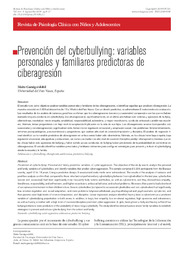Por favor, use este identificador para citar o enlazar este ítem:
https://hdl.handle.net/11000/5507Registro completo de metadatos
| Campo DC | Valor | Lengua/Idioma |
|---|---|---|
| dc.contributor.author | Garaigordobil, Maite | - |
| dc.contributor.other | Departamentos de la UMH::Psicología de la Salud | es |
| dc.date.accessioned | 2019-12-09T08:35:06Z | - |
| dc.date.available | 2019-12-09T08:35:06Z | - |
| dc.date.created | 2019-09 | - |
| dc.date.issued | 2019-12-09 | - |
| dc.identifier.issn | 2340-8340 | - |
| dc.identifier.uri | http://hdl.handle.net/11000/5507 | - |
| dc.description.abstract | El estudio tuvo como objetivos analizar variables personales y familiares de los ciberagresores, e identificar aquellas que predicen ciberagresión. La muestra consistió en 3.026 adolescentes de 12 a 18 años del País Vasco. Con un diseño predictivo, se administraron 8 instrumentos de evaluación. Los resultados de los análisis de varianza y post hoc confirman que los ciberagresores (severos y ocasionales) comparados con los que no habían realizado ninguna conducta de cyberbullying (no-ciberagresores), significativamente, en el último año habían sido víctimas y agresores de bullying, cibervíctimas, mostraban menor empatía, amabilidad, responsabilidad, autoestima, y mayor neuroticismo, conducta antisocial y problemas escolares. Además, tenían progenitores con bajo nivel de aceptación/implicación en la vida de sus hijos. Los ciberagresores severos (comparados con ocasionales y no-ciberagresores), significativamente, tenían menor regulación emocional y adaptación social, más problemas (timidez-retraimiento, síntomas psicopatológicos, psicosomáticos) y progenitores que usaban alto nivel de coerción/imposición y disciplina. El análisis de regresión lineal identificó como variable predictora de ciberagresión en ambos sexos haber sido cibervíctima. Además, en los chicos tener baja empatía, baja regulación emocional, alta apertura y extraversión, así como una madre con alto nivel de coerción/disciplina predijo ciberagresión; mientras que en las chicas haber sido agresoras de bullying y haber sufrido pocas conductas de bullying fueron predictores de la probabilidad de convertirse en ciberagresoras. El estudio identifica variables personales y familiares relevantes para configurar estrategias para prevenir y reducir el cyberbullying desde la escuela y la familia. | es |
| dc.description.abstract | Prevention of cyberbullying: Personal and family predictive variables of cyber-aggression. The objective of the study was to analyze the personal and family variables of cyberbullies, and identify variables that predict cyber-aggression. The sample comprised 3,026 participants from the Basque country, aged 12 to 18 years. Using a predictive design, 8 assessment instruments were administered. The results of the analysis of variance and post-hoc analysis confirm that, compared to those who had not performed any cyberbullying behavior (non-cyberbullies) in the last year, cyberbullies (severe and occasional) had been significantly more frequently bully victims and bullies, as well as cybervictims, and they showed less empathy, friendliness, responsibility, and self-esteem, and higher neuroticism, antisocial behavior, and school problems. Moreover, their parents had a low level of acceptance/involvement in their children’s lives. Severe cyberbullies (compared to occasional cyberbullies and non-cyberbullies) had significantly less emotion regulation and social adaptation, and more problems (shyness-withdrawal, psychopathological and psychosomatic symptoms), and their parents used high levels of coercion/imposition, and discipline. Linear regression analysis identified having been a cybervictim as a predictor variable of cyberbullying perpetration in both sexes. In addition, in boys, low empathy, low emotional regulation, high openness and extraversion, as well as having a mother with a high level of coercion/discipline predicted cyber-aggression. In girls, having been a bully and having suffered few bullying behaviors were predictors of the probability of becoming a cyberbully. The study identifies relevant personal and family variables to establish strategies to prevent and reduce cyberbullying from the school and family. | es |
| dc.format | application/pdf | es |
| dc.format.extent | 9 | es |
| dc.language.iso | spa | es |
| dc.rights | info:eu-repo/semantics/openAccess | es |
| dc.subject | cyberbullying | es |
| dc.subject | ciberagresión | es |
| dc.subject | adolescencia | es |
| dc.subject | predictores | es |
| dc.subject | bullying | es |
| dc.subject.other | CDU::1 - Filosofía y psicología::159.9 - Psicología | es |
| dc.title | Prevención del cyberbullying: variables personales y familiares predictoras de ciberagresión | es |
| dc.type | info:eu-repo/semantics/article | es |

Ver/Abrir:
1910-2_0.pdf
228,12 kB
Adobe PDF
Compartir:
 La licencia se describe como: Atribución-NonComercial-NoDerivada 4.0 Internacional.
La licencia se describe como: Atribución-NonComercial-NoDerivada 4.0 Internacional.
.png)